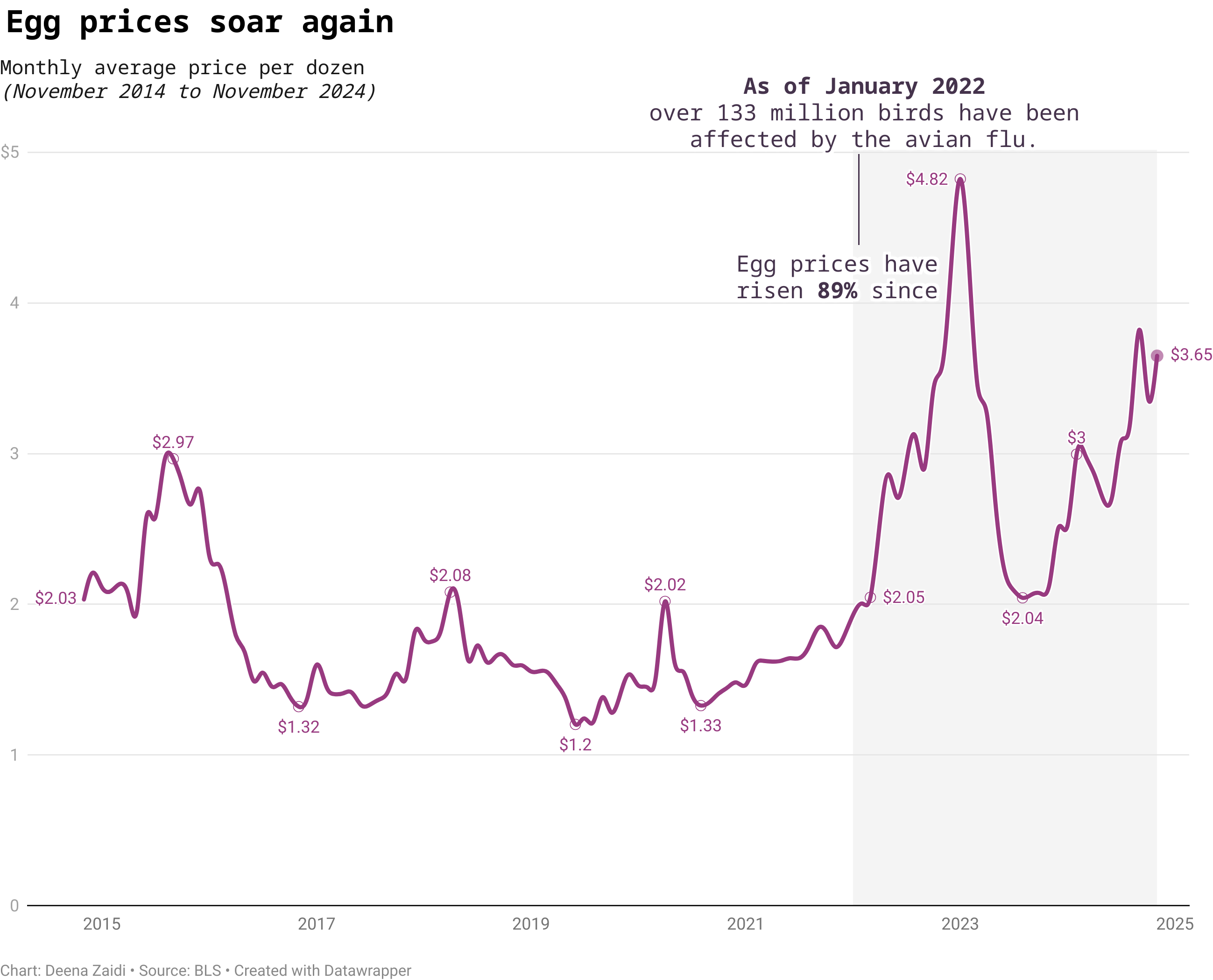The story has been updated since it was last published on Aug. 20, 2024
Egg prices have been surging with many grocery stores highlighting a deeper concern behind the price hike.
The price: The latest numbers by the United States Department of Agriculture (USDA) Egg Markets Overview show that the national wholesale price for a dozen eggs were up by 94%—from $2.50 on November 29, 2024 to $4.85 on January 3, 2025.
- In November last year, egg prices had climbed 71% compared to a year ago, far outpacing the overall food index, which increased by 2.4% over the same period.
- Not just that, monthly data from U.S. Bureau of Labor Statistics (BLS) shows that average cost of a dozen (Grade A) large eggs have risen more than 110% in just two years— from $1.72 in 2022 to $3.65 in November last year.
The supply: The bird flu outbreak, which started in early 2022, is considered the largest bird flu outbreak in U.S. history, severely impacting supply chains.
- The increased frequency of natural disasters across the country is a huge reason for many displaced birds, leading them into areas where they’ve never been seen before.
- This means heightened risk of disease transmission from wild birds to domesticated ones.
Chad Hart, a professor and agricultural economist at Iowa State University, explained to PBS,, “It’s really hard to control that interaction between domesticated birds and wild birds. Some of those vectors have been opened up because we’re asking the egg industry to produce in ways that we didn’t ask them to before.”
- As of Jan. 10, 2025, more than 10,000 wild birds have been detected with the flu. Once the infection is detected, farmers take required measures to ensure the rest of the supply is not affected.
- In its recent report, the Centers for Disease Control and Prevention (CDC) highlighted that as of Jan. 10, 2025, roughly 133 million birds had been affected since January 2022.
- As many as 599 U.S. counties have been impacted by the avian flu, with a total of 1,393 reported outbreaks.
- While egg prices eased in 2023 due to the decline in the number of bird flu cases, egg producers reported a resurgence of the virus starting in November 2023. Prices spiked by 50% since as supply dwindled due to the loss of birds affected by the virus.
- In 2024 alone, a combination of highly pathogenic avian influenza (HPAI) outbreaks and facility fires resulted in the loss of nearly 40 million commercial table egg layers in 12 states (AZ, CA, CO, IA, IL, MI, MN, OH, OR, UT, WA, and TX). Commercial layers refers to the chickens that lay eggs.
- Due to an outbreak, egg layer losses typically means more time for facilities to adjust to recover the supply disrupted by the outbreak.
But the impact of avian flu extends beyond just eggs.
Avian flu is now spilling over to other food products such as poultry and milk.
A recent research published late last year revealed that influenza or flu virus can remain infectious in refrigerated raw milk for up to five days.
The findings come at a time when outbreaks of bird flu in dairy cattle have raised concerns about a new pandemic.
While the current public health risk is low, CDC is working with states to monitor people with animal exposure.
As avian flu continues to disrupt food production and supply chains, its far-reaching effects are becoming more evident, pushing for recalls, increased testing procedures, and signaling the need for preventive measures in the agricultural industry.
